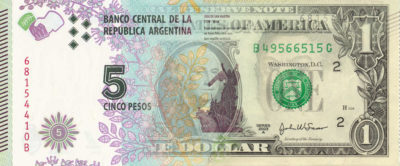Currency boards and dollarization
Sometimes sound money has to be imported from abroad. Some countries, like Ecuador, are dollarized. Ecuador dollarized its economy in the year 2000.
Others countries don’t go that far, but get quite close, by imposing currency boards.
During the 1990s, Argentina had a currency board where 1 Argentine peso could be converted for 1 US dollar. Hyperinflation ended abruptly and the monetary conditions of the country improved drastically and quite fast. Dollarization does not mean that a country uses the US dollar, it simply means that it uses a foreign currency (i.e. the Australian dollar, the British pound, etc.)
If, for instance, Scotland had voted for independence but kept using the British pound, then Scotland would be “dollarized.” Similarly, the US could dollarize its economy by starting to use the Canadian dollar. The same holds true for a currency board; the country may issue banknotes convertible to a foreign currency other than the US dollar.
Both, Argentina and Ecuador benefited from importing “currency institutions” from abroad. Don’t get me wrong; I’m not saying that the Federal Reserve is the ideal of a central bank. Far from it. Studies actually show that the Federal Reserve’s performance is worse than the pre-Fed monetary arrangements (see here).
I’m also not saying that the US dollar should be the currency of choice for an economy that decides to directly or indirectly use a foreign currency. Some countries, however, are better off using a foreign currency rather than relying on their own policymakers to provide their domestic currency.
For the country that either goes to a currency board or dollarization, the main benefit is the tying of the hands of central bankers, effectively putting an end to the printing of money in order to finance treasury deficits. It is a way to control government deficit increasing the political cost of high deficits.
After the crisis in 2001 Argentina decided to discontinue the currency board and devalue its currency. The alternative was to take the next step and just dollarize the economy. The result was a messy dollarization. Today, in Argentina, people save in US dollars. Durable goods are priced in US dollars. The economy is informally dollarized. Dollarization, broadly understood, is a market decision, not a political decision. What policy makers can do is facilitate the situation, or just make things worse.
The Federal Reserve, however, is not unaffected by these events. The US dollar is the international currency, which means that US monetary policy is affected by the international market, and is therefore not only a domestic issue. For the Federal Reserve, the market is the world, not just the US. But its political mandate is to focus on the US economy, not the world economy. This is not a matter of choice. This is a fact. And this means that to optimize the domestic objectives, the Fed needs to look at the international effects of its policy and not get carried away by looking only at domestic variables as has been argued was the case in the years prior to the 2008 crisis.
It might be argued that it is not the US fault if other countries decide to use the US dollars. But it is not so straightforward. Before fiat currencies, there was the gold standard. The Gold Standard is based on a nationless currency: gold. And it was the US who unilaterally closed the gold window in 1971 giving an end to the Gold Exchange Standard from Bretton Woods and leaving the rest of the world to use unconvertible US dollars.
By providing sound money, the Federal Reserve would not only benefit the US, but also its trade partners and the economic prospect of smaller and more troubled economies.









